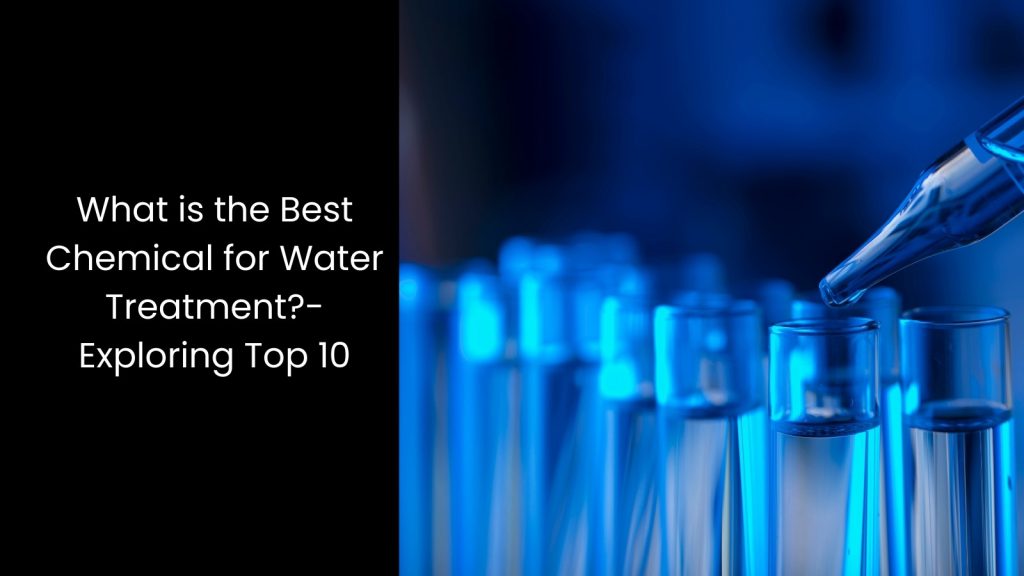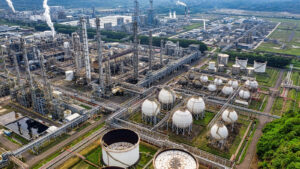When most people think of water treatment chemicals, the first one that comes to mind is chlorine. In a way, nothing to astonish, as it certainly is the most well-known disinfectant, widely used to make our drinking water safe. However, water treatment is a complex process that goes far beyond just chlorine. There are many different chemicals involved, each playing a specific role in purifying, softening, or treating water. From removing contaminants to preventing corrosion, these chemicals ensure water systems run smoothly and safely.
In this article, we explore the top 10 water treatment chemicals, shedding light on their essential roles and how they contribute to cleaner, safer water for all.
In this article, we explore the top 10 water treatment chemicals, shedding light on their essential roles and how they contribute to cleaner, safer water for all.
What is the Best Chemical for Water Treatment?-Exploring Top 10

Citric Acid
Citric acid plays a vital role in the water treatment industry as an effective scale remover.
This weak organic acid works by binding with metal ions through chelation, which helps dissolve and break down limescale and mineral deposits. These deposits often form in pipes, boilers, and evaporators, lowering efficiency and causing blockages.
As it removes these build-ups, citric acid promotes smooth water flow and extends the life of machinery. Its natural chelating properties are ideal for softening water and preventing future scale formation.
Widely appreciated for being environmentally friendly and biodegradable, citric acid ensures water systems operate efficiently and remain free from damaging mineral build-ups, enhancing overall performance.
This weak organic acid works by binding with metal ions through chelation, which helps dissolve and break down limescale and mineral deposits. These deposits often form in pipes, boilers, and evaporators, lowering efficiency and causing blockages.
As it removes these build-ups, citric acid promotes smooth water flow and extends the life of machinery. Its natural chelating properties are ideal for softening water and preventing future scale formation.
Widely appreciated for being environmentally friendly and biodegradable, citric acid ensures water systems operate efficiently and remain free from damaging mineral build-ups, enhancing overall performance.
Ferric Chloride
Ferric chloride takes centre stage in the water treatment industry as a powerful coagulant. It works by causing fine particles and impurities in water to clump together into larger clusters called flocs.
These flocs make it easier to remove contaminants through filtration or sedimentation. Wastewater treatment plants commonly use ferric chloride to remove phosphates and suspended solids, which helps prevent water pollution.
Since it binds these particles together, ferric chloride improves water clarity and quality. It also helps control odours and reduce harmful nutrients in water systems. Its effectiveness, reliability, and versatility make ferric chloride an essential chemical for maintaining clean and safe water in industrial and municipal settings.
These flocs make it easier to remove contaminants through filtration or sedimentation. Wastewater treatment plants commonly use ferric chloride to remove phosphates and suspended solids, which helps prevent water pollution.
Since it binds these particles together, ferric chloride improves water clarity and quality. It also helps control odours and reduce harmful nutrients in water systems. Its effectiveness, reliability, and versatility make ferric chloride an essential chemical for maintaining clean and safe water in industrial and municipal settings.
Ferric Sulphate
Known as a coagulant in water treatment, ferric sulphate helps remove impurities by causing suspended solids to clump together into larger particles or flocs.
These flocs settle quickly, making it easier to remove contaminants through filtration or sedimentation.
Plus, ferric sulphate works well for treating industrial wastewater and removing stubborn colloidal particles that are hard to separate. It improves water clarity and reduces pollutants like heavy metals and organic matter. By enhancing the coagulation process, ferric sulphate helps prevent blockages and keeps water systems running efficiently.
Its effectiveness, especially in challenging wastewater conditions, makes it a reliable choice for maintaining clean, treated water in industrial and municipal systems.
These flocs settle quickly, making it easier to remove contaminants through filtration or sedimentation.
Plus, ferric sulphate works well for treating industrial wastewater and removing stubborn colloidal particles that are hard to separate. It improves water clarity and reduces pollutants like heavy metals and organic matter. By enhancing the coagulation process, ferric sulphate helps prevent blockages and keeps water systems running efficiently.
Its effectiveness, especially in challenging wastewater conditions, makes it a reliable choice for maintaining clean, treated water in industrial and municipal systems.
Hydrochloric Acid
This is commonly used as a pH adjuster and descaling agent in the water treatment industry.
Hydrochloric acid, or HCl, effectively lowers the pH of alkaline water, making it more suitable for industrial processes. When water becomes too alkaline, it can cause corrosion or reduce treatment efficiency.
HCl helps balance the pH, ensuring proper system operation.
Additionally, hydrochloric acid dissolves limescale and mineral deposits that form in boilers, heat exchangers, and pipes. When breaking down these deposits, it maintains smooth water flow, prevents blockages, and improves system efficiency. Its powerful properties make hydrochloric acid essential for maintaining clean, efficient, and well-functioning water treatment systems in various industries.
Hydrochloric acid, or HCl, effectively lowers the pH of alkaline water, making it more suitable for industrial processes. When water becomes too alkaline, it can cause corrosion or reduce treatment efficiency.
HCl helps balance the pH, ensuring proper system operation.
Additionally, hydrochloric acid dissolves limescale and mineral deposits that form in boilers, heat exchangers, and pipes. When breaking down these deposits, it maintains smooth water flow, prevents blockages, and improves system efficiency. Its powerful properties make hydrochloric acid essential for maintaining clean, efficient, and well-functioning water treatment systems in various industries.
Hydrogen Peroxide
Being a powerful oxidising agent, hydrogen peroxide plays an important role in water treatment by effectively disinfecting water. It breaks down harmful contaminants like bacteria, viruses, and organic matter, ensuring water safety and purity.
As hydrogen peroxide works, it decomposes into water and oxygen, leaving no harmful residues behind.
This makes it an eco-friendly alternative to chlorine and other chemical disinfectants. Water treatment facilities use it to control odours, remove pollutants, and improve water quality without adding toxic by-products.
Its versatility and environmental safety make hydrogen peroxide an excellent choice for maintaining clean water in both drinking water systems and wastewater treatment processes.
As hydrogen peroxide works, it decomposes into water and oxygen, leaving no harmful residues behind.
This makes it an eco-friendly alternative to chlorine and other chemical disinfectants. Water treatment facilities use it to control odours, remove pollutants, and improve water quality without adding toxic by-products.
Its versatility and environmental safety make hydrogen peroxide an excellent choice for maintaining clean water in both drinking water systems and wastewater treatment processes.
Phosphoric Acid
The main reason this chemical is in use is that it is a good corrosion inhibitor in the water treatment industry.
Phosphoric acid protects metal pipes and tanks by creating a layer of phosphate salts that prevents rust and corrosion. This protective layer shields infrastructure, especially in systems where water contains corrosive elements.
Since the latter reduces the risk of corrosion, phosphoric acid extends the lifespan of pipes, boilers, and storage tanks. It also helps maintain water flow efficiency by preventing blockages caused by rust build-up. This is what makes it valuable for industries that rely on metal infrastructure. Also, phosphoric acid ensures that systems remain durable, reliable, and safe for long-term use.
Phosphoric acid protects metal pipes and tanks by creating a layer of phosphate salts that prevents rust and corrosion. This protective layer shields infrastructure, especially in systems where water contains corrosive elements.
Since the latter reduces the risk of corrosion, phosphoric acid extends the lifespan of pipes, boilers, and storage tanks. It also helps maintain water flow efficiency by preventing blockages caused by rust build-up. This is what makes it valuable for industries that rely on metal infrastructure. Also, phosphoric acid ensures that systems remain durable, reliable, and safe for long-term use.
Poly Aluminium Chloride (PAC)
Employed as another highly effective coagulant, Poly Aluminium Chloride (PAC) plays a key role in the water treatment industry. It removes suspended solids and organic materials by making tiny particles stick together to form larger flocs.
These flocs can be easily filtered out or removed through sedimentation. PAC works well across a wide pH range, making it adaptable to different water conditions.
It speeds up the clarification process and improves water quality, whether in drinking water treatment or wastewater management.
Further, PAC reduces sludge volume, which lowers disposal costs. Its versatility and efficiency make PAC an essential chemical for keeping water clean, clear, and safe.
These flocs can be easily filtered out or removed through sedimentation. PAC works well across a wide pH range, making it adaptable to different water conditions.
It speeds up the clarification process and improves water quality, whether in drinking water treatment or wastewater management.
Further, PAC reduces sludge volume, which lowers disposal costs. Its versatility and efficiency make PAC an essential chemical for keeping water clean, clear, and safe.
Sodium Chlorite
Known for its role as a precursor to chlorine dioxide, sodium chlorite is an essential chemical in the water treatment industry.
When activated, sodium chlorite produces chlorine dioxide, a powerful disinfectant that kills bacteria, viruses, and other harmful microorganisms.
Water treatment plants use chlorine dioxide for its strong oxidising properties, making it highly effective at purifying drinking water. Unlike traditional chlorine, chlorine dioxide does not create harmful by-products, making it a safer option.
Sodium chlorite helps maintain water quality by ensuring thorough disinfection without unwanted residues. Not to mention that this is truly valuable for municipal water systems, providing clean, safe water for communities.
When activated, sodium chlorite produces chlorine dioxide, a powerful disinfectant that kills bacteria, viruses, and other harmful microorganisms.
Water treatment plants use chlorine dioxide for its strong oxidising properties, making it highly effective at purifying drinking water. Unlike traditional chlorine, chlorine dioxide does not create harmful by-products, making it a safer option.
Sodium chlorite helps maintain water quality by ensuring thorough disinfection without unwanted residues. Not to mention that this is truly valuable for municipal water systems, providing clean, safe water for communities.
Sodium Hypochlorite
This is a well-known disinfectant in the water treatment industry.
Sodium hypochlorite, commonly called bleach, releases chlorine when added to water. This chlorine effectively destroys harmful pathogens like bacteria, viruses, and algae, making the water safe for drinking and other uses.
Water treatment facilities use it to sanitise drinking water, swimming pools, and wastewater. Also, sodium hypochlorite helps control odours and prevents the spread of waterborne diseases. It works quickly, ensuring rapid disinfection while maintaining water quality.
Due to its availability, cost-effectiveness, and powerful disinfecting properties, sodium hypochlorite remains one of the most trusted solutions for keeping water systems clean and safe.
Sodium hypochlorite, commonly called bleach, releases chlorine when added to water. This chlorine effectively destroys harmful pathogens like bacteria, viruses, and algae, making the water safe for drinking and other uses.
Water treatment facilities use it to sanitise drinking water, swimming pools, and wastewater. Also, sodium hypochlorite helps control odours and prevents the spread of waterborne diseases. It works quickly, ensuring rapid disinfection while maintaining water quality.
Due to its availability, cost-effectiveness, and powerful disinfecting properties, sodium hypochlorite remains one of the most trusted solutions for keeping water systems clean and safe.
Sodium Molybdate
As a reliable corrosion inhibitor, sodium molybdate protects metal surfaces in water systems.
It forms a protective layer that shields equipment like pipes, cooling towers, and boilers from rust and corrosion. This protective barrier helps prevent damage caused by exposure to oxygen and moisture, extending the lifespan of critical infrastructure.
Sodium molybdate works well in both hot and cold water systems, making it versatile for different conditions. Industries tend to use it to maintain system efficiency, reduce maintenance costs, and avoid downtime caused by corrosion-related failures.
Its non-toxic nature also makes it safer for the environment than other inhibitors, ensuring long-lasting and reliable water treatment solutions.
It forms a protective layer that shields equipment like pipes, cooling towers, and boilers from rust and corrosion. This protective barrier helps prevent damage caused by exposure to oxygen and moisture, extending the lifespan of critical infrastructure.
Sodium molybdate works well in both hot and cold water systems, making it versatile for different conditions. Industries tend to use it to maintain system efficiency, reduce maintenance costs, and avoid downtime caused by corrosion-related failures.
Its non-toxic nature also makes it safer for the environment than other inhibitors, ensuring long-lasting and reliable water treatment solutions.
Conducting Chemical Performance Analysis Using AI-Driven Tools

The time for passive monitoring of chemical performance is over. It is time to take proactive steps to ensure the optimal functioning of our water treatment systems. Since we have stepped into the ‘AI Era,’ adopting AI-driven tools is the best way to revolutionise how we approach water treatment, maximising efficiency, minimising costs, and safeguarding our environment. Incorporating the industry expertise is simply another word for ‘streamlining work’ in the water treatment industry.







